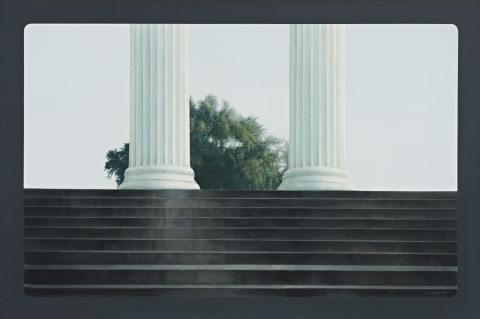COLUMNS, 1973
William Delafield Cook
synthetic polymer paint on canvas
101.5 x 152.0 cm
signed and dated lower right: W Delafield Cook 73
The Redfern Gallery, London (label attached verso)
Private collection, Melbourne, acquired from the above in 1973
William Delafield Cook, New Paintings and Drawings, The Redfern Gallery, London, 6 – 28 June 1973 (cover illus.)
William Delafield Cook Survey Exhibition, University Gallery, University of Melbourne, 17 May – 2 July; Art Gallery of New South Wales, Sydney, 2 July – 29 August; Newcastle Region Art Gallery, 16 September – 10 October; Art Gallery of South Australia, Adelaide, 5 November – 5 December 1976, cat. 13 (illus.)
Hart, D., William Delafield Cook, Craftsman House, Sydney, 1998, p. 98 (illus.)
William Delafield Cook thought so highly of Columns 1973 that he illustrated it in colour on the cover of the catalogue to his second solo exhibition at London's Redfern Gallery. Cook was in good company for the prestigious Redfern was very supportive of leading Australian artists. Ian Fairweather held exhibitions there from 1936 to 1948; and Sidney Nolan's first London exhibition at Redfern in 1951 helped launch his international career. Closer to Cook, Jeffrey Smart had three solo shows at Redfern between 1967 and 1982. Cook's exhibition was a great success, selling works to Elton John, film director Bryan Forbes, and others. Influenced by the early photography of Henry Fox Talbot and its innocence of vision, Cook commented on the stillness in his paintings, 'as if the world had been frozen for an instant which is very much the quality I have tried to achieve.'1 Selection is also a key to their fascination, as well as an early interest in contrasting the man made with the natural. Selectivity and contrast are central to Columns, its imagery being based on those, as Cook noted, of 'the National Gallery in London on Trafalgar Square, as you approach them up the steps - but instead of St. Martins in the Field I substituted part of a tree.'2 The source of the tree is a 1971 painting, simply titled 'Tree', the softer outline and light grey sky reflective of the subtler northern atmosphere, contrasting with the bright sharpness of his Australian paintings such as A Government-House, 1969-70.
Blandness of titles in company with deadpan surfaces play an important role in the objectivity of these paintings. There is also the isolation of the motif, as in those paintings Gate, 1973, and A Fence, 1974-75, in the collection of the Art Gallery of South Australia. In Mountains, 1972-74, which hung near Columns in his 1973 exhibition, tantalising notions of romanticism and the sublime are dealt with in the most objective manner through its knife-edge handling of the visual cliché. It is now in the collection of the Newcastle Region Art Gallery. Moreover, people are never present in his paintings and drawings, although their previous presence is often a characteristic feature. With today's tourist hoards, it is almost unthinkable to imagine the absence of crowds on the steps of London's National Gallery. The closed view, columns cut off part way up, identifying associations absent, gives Columns the informality of a photograph. But Cook's art is an art that transcends photography. Using the magnet of realism and seeming simplicity of statement, he creates, through their visual play, paintings of intriguing complexity.
1. Hart, D., William Delafield Cook , Craftsman House, Sydney, 1998, p. 100
2. ibid., p. 98
DAVID THOMAS
